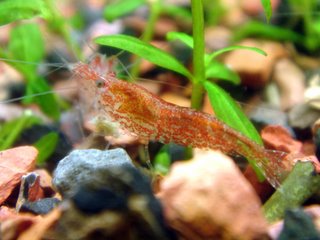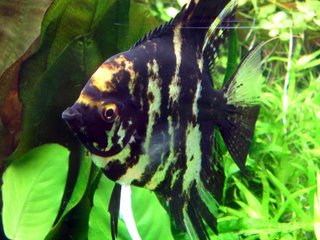- pH:
- Temp:
- KH:
- GH:
- NH4:
- NO2:
- NO3:
- PO4:
- Iron:
- Dosing: 10 mL Flourish, 15 mL Excel, 25 mL Melafix
- NO3:PO4 Cumulative Dosing Ratio:
Notes:The newest batch of angelfish fry are developing eyes on day 4, right on schedule. This typical development timetable is from a very useful
Angelfish breeding FAQ site:
Day 0: Eggs spawned in streaks, are clear or translucent.
Day 1: Some infertile eggs turn white.
Day 2: More eggs turn white, wiggling tails emerge from clear eggs. Some white eggs may get fuzzy.
Day 3: Tadpole shape forms with large yolk sack, fry remain stuck to the slate.
Day 4: Small eyes form.
Day 5: Eyes grow large, yolk sack shrinks. Start brine shrimp hatchery.
Day 6: Some fry are free swimming.
Day 7: All free swimming, time to start feeding.
My fry have followed this timetable of development exactly.
I've started to try to wean the older batch of 4 fry onto fish flakes, crumbling small pieces of fish flake into their tank. So far, they'll mouth it and spit it back out. We'll see how they feel about it after I start decreasing the baby brine shrimp...
I'm still having trouble hatching the brine shrimp eggs. I don't have a hydrometer, so I don't know if I'm adding too much salt. Today's batch has 4 tsp salt versus the usual 7 tsp salt in 1.5 liters water. After reading about a
guy who is able to hatch his brine shrimp in fresh water, I've started another batch in fresh water and 3 tsp of baking soda. If neither of these changes work, I'll have to go to the petstore and buy ocean salt and a hydrometer.













 A closeup of he fry (busy pooping out digested brine shrimp). You can see the striping and coloring start to develop on the fish.
A closeup of he fry (busy pooping out digested brine shrimp). You can see the striping and coloring start to develop on the fish. In the tank picture above, you can see the two breeding cages holding the two sets of fry.
In the tank picture above, you can see the two breeding cages holding the two sets of fry.





